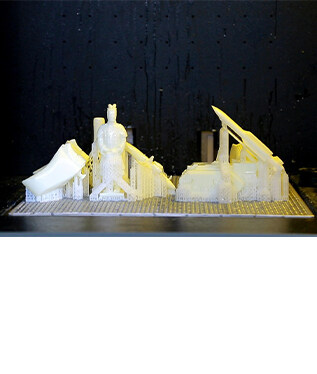Email format error
Email cannot be empty
Email already exists
6-20 characters(letters plus numbers only)
The password is inconsistent
Email format error
Email cannot be empty
Email does not exist
6-20 characters(letters plus numbers only)
The password is inconsistent


Embracing the Future: Exploring the Advantages of Rapid 3D Printing in Manufacturing
In today's fast-paced world, the manufacturing industry is constantly seeking innovative solutions to streamline processes, reduce costs, and meet the ever-changing demands of consumers. One technology that has emerged as a game-changer in this regard is rapid 3D printing. Rapid 3D printing, also known as additive manufacturing, is revolutionizing traditional manufacturing processes by offering unprecedented speed, flexibility, and customization capabilities.
Introduction to Rapid 3D Printing
Rapid 3D printing fundamentally alters the production process by building up materials rather than subtracting them. This additive approach allows for the creation of intricate designs and complex geometries with unprecedented ease and precision. Unlike traditional manufacturing methods that often require expensive tooling and lengthy setup times, rapid 3D printing offers a streamlined workflow that significantly reduces lead times and production costs.
The evolution of rapid 3D printing technology has been nothing short of remarkable. From its humble beginnings as a niche prototyping tool to its current status as a mainstream manufacturing solution, rapid 3D printing has undergone rapid advancements in both hardware and software capabilities. Today, rapid 3D printers are capable of producing high-quality, end-use parts across a wide range of industries, from aerospace and automotive to healthcare and consumer goods.

Benefits of Rapid 3D Printing Services
Prototyping is an essential stage in product development, allowing designers and engineers to test and refine their concepts before moving into full-scale production. Rapid 3D printing revolutionizes this process by providing unprecedented speed and flexibility.
One of the primary advantages of rapid 3D printing for prototyping is the rapid turnaround time. Design iterations that once took weeks or even months using traditional methods can now be completed in a matter of days with rapid 3D printing. This accelerated timeline enables designers to iterate quickly, test multiple design concepts, and refine their ideas in real-time, ultimately speeding up the product development cycle and reducing time-to-market.
Furthermore, rapid 3D printing allows for the creation of complex geometries and intricate designs that would be difficult or impossible to achieve using conventional prototyping methods. This freedom of design enables designers to explore new possibilities and push the boundaries of innovation, resulting in more creative and innovative products.
Cost savings are another significant advantage of rapid 3D printing for prototyping. Traditional prototyping methods often require expensive tooling and setup costs, making it prohibitively expensive to test multiple design iterations. In contrast, rapid 3D printing eliminates the need for tooling and allows for on-demand production of prototypes, significantly reducing costs and enabling more experimentation and iteration.
Materials Used in Rapid 3D Printing
One of the most compelling aspects of rapid 3D printing is the extensive range of materials that can be used to create objects. From plastics and metals to ceramics and composites, there is a material suitable for virtually any application, each offering its own set of advantages and characteristics.
Plastics are among the most commonly used materials in rapid 3D printing, owing to their versatility, affordability, and ease of printing. Thermoplastics such as ABS, PLA, and PETG are popular choices for prototyping and low-cost production due to their excellent printability and wide range of available colors and finishes.
Metals are another important category of materials used in rapid 3D printing, particularly for applications that require high strength, durability, and heat resistance. Metals such as titanium, aluminum, and stainless steel are commonly used in industries such as aerospace, automotive, and healthcare, where performance and reliability are paramount.
Ceramics and composites offer unique properties that make them well-suited for specific applications in rapid 3D printing. Ceramics such as porcelain and alumina are valued for their heat resistance and electrical insulation properties, making them ideal for producing components for electronic devices and high-temperature applications. Composites, which consist of a combination of two or more materials, offer enhanced strength, stiffness, and durability compared to traditional materials, making them ideal for producing lightweight, high-performance parts for aerospace and automotive applications.
Comparison with Traditional Manufacturing Methods
Speed of Production
One of the most significant advantages of rapid 3D printing over traditional manufacturing methods is its speed of production. Traditional manufacturing processes often involve lengthy setup times and lead times, requiring tooling and molds to be created before production can begin. In contrast, rapid 3D printing eliminates the need for tooling and allows for parts to be produced directly from digital design files, significantly reducing lead times and accelerating the production process.
Cost Analysis
Traditional manufacturing methods often require expensive tooling and molds to be created before production can begin, resulting in high upfront costs. Additionally, traditional manufacturing processes may involve material waste, as parts are often machined from larger blocks of material, resulting in excess material being discarded.
In contrast, rapid 3D printing eliminates the need for tooling and allows for parts to be produced on-demand, reducing material waste and eliminating the need for expensive molds. While the cost per part may be higher for rapid 3D printing compared to traditional manufacturing methods, the overall cost savings in terms of reduced setup times, material waste, and labor costs can make rapid 3D printing a more cost-effective solution, particularly for small-batch production runs.
Quality Considerations
While rapid 3D printing offers numerous advantages over traditional manufacturing methods, there are also important considerations to take into account in terms of quality. Traditional manufacturing methods often produce parts with superior surface finish and dimensional accuracy compared to rapid 3D printing, particularly for high-precision applications.
In conclusion, rapid 3D printing is transforming the manufacturing landscape, offering unprecedented speed, flexibility, and customization capabilities. From rapid prototyping to on-demand production, the benefits of rapid 3D printing are clear. By embracing this innovative technology, manufacturers can stay ahead of the competition, meet evolving customer demands, and drive growth in the digital age.
